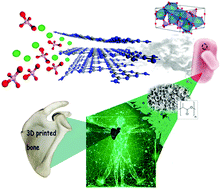Template-oriented synthesis of hydroxyapatite nanoplates for 3D bone printing†
Abstract
The design of hydroxyapatite (HA) nanoarchitecture is critical for fabricating artificial bone tissues as it dictates the biochemical and the mechanical properties of the final product. Herein, we incorporated a simple hard-template approach to synthesise single crystal nanoplates of HA. We used the 2D graphitic nitride (g-C3N4) material to prepare an HA sol–gel under hydrothermal conditions. A new HA nanostructure was then formed during the calcination and removal of g-C3N4 at a higher temperature, which finally led to the production of nanoplates (thickness of ∼100 nm) while in lateral dimension the average size was in the micrometre scale. We characterised the synthesised HA nanoplates with XRD, TEM, and HRTEM. The theoretically predicted nanostructure construction based on Wulff's method is in full agreement with the experimental observations. We then prepared different weight ratios of HA and polylactic acid (PLA) composites for artificial 3D bone fabrication. The strong interaction between PLA and HA's (110) facet, which was the second most prevalent, resulted in the composite's mechanical robustness. After mechanical testing, an optimum ratio was selected for biological studies and 3D printing. Biological experiments demonstrated that the synthesised composite had excellent viability in vitro.



 Please wait while we load your content...
Please wait while we load your content...